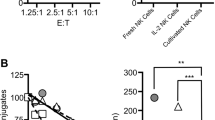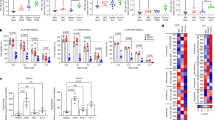Abstract
The mechanism of tumour cell destruction by natural killer (NK) cells or other lymphocytes is not understood. NK cells appear to represent a primitive anti-tumour surveillance system more analogous to macrophages than lymphocytes1. Free oxygen radicals (O−2, OH) and H2O2 are thought to be involved in cell destruction by macrophages2 and therefore we looked for similar cytocidal intermediates of oxygen in NK cells. These highly reactive molecular species can easily be detected in the presence of luminol by the emission of light3. We show here that highly enriched human NK cells respond to NK-sensitive but not NK-insensitive tumour cells with a rapid burst of oxygen metabolites as detected both by chemiluminescence and cytochrome c reduction. Agents which can prevent chemiluminescence and cytochrome c reduction, such as superoxide dismutase (SOD), reduced NK-mediated cytolysis and agents which increased chemiluminescence, such as interferon, also increased NK-mediated cytolysis. These results suggest that the production of oxygen species may be the earliest event to occur in the NK cell following tumour cell contact, and these products are involved in NK-mediated cytolysis.
Similar content being viewed by others
References
Babior, B. M. New Engl. J. Med. 298, 659–668 (1978).
Roder, J. C., Karre, K. & Kiessling, R. Prog. Allergy, 28, 66–159 (1981).
Allen, R. C., Stjernholm, R. L. & Steele, R. H. Biochem. biophys. Res. Commun. 47, 679–684.
Timonen, T. & Saksela, E. J. immun. Meth. 36, 285–291 (1980).
Abo, T. & Balch, C. M. J. Immun. 127, 1024–1029 (1981).
Zarling, J. M. & Kung, P. C. Nature 288, 394–396 (1980).
Ault, K. & Springer, T. J. Immun. 126, 359–364 (1981).
Kung, P. C., Goldstein, G., Reinherz, E. & Schlossman, S. Science 206, 347–349 (1979).
Reinherz, E. et al. J. exp. Med. 150, 1472–1482 (1979).
Todd, R. F., Nadlér, L. M. & Schlossman, S. J. Immun. 126, 1435–1442 (1981).
Helfand, S., Werkmeister, J. & Roder, J. C. J. exp. Med. 156 (in the press).
Nathan, C. F., Silverstein, S. C., Brukner, L. H. & Cohn, Z. A. J. exp. Med. 149, 100–113 (1979).
Werkmeister, J. et al. Cell. Immun. 68 (in the press).
Roder, J. C. et al. Nature 284, 553–555 (1980).
Wrogemann, K., Weidemann, M. J., Ketelson, U. P., Wekerle, H. & Fisher, H. Eur. J. Immun. 10, 36–40 (1980).
Nelson, R. D., Mills, E. L., Simmons, R. L. & Quil, P. G. Infect. Immunity 14, 129–134 (1976).
Simchowitz, L. & Spilberg, I. Immunology 37, 301–309 (1979).
Devlin, R. G., Lin, C. S., Peper, R. J. & Dougherty, H. Immunopharmacology 3, 147–159 (1981).
Timonen, T., Ortaldo, J. R. & Herberman, R. B. J. exp. Med. 153, 569–582 (1981).
McCord, J. M. & Fridovich, I. J. biol. Chem. 244, 6049–6055 (1969).
Secher, D. S. & Burke, D. C. Nature 285, 446–450 (1980).
Author information
Authors and Affiliations
Rights and permissions
About this article
Cite this article
Roder, J., Helfand, S., Werkmeister, J. et al. Oxygen intermediates are triggered early in the cytolytic pathway of human NK cells. Nature 298, 569–572 (1982). https://doi.org/10.1038/298569a0
Received:
Accepted:
Issue Date:
DOI: https://doi.org/10.1038/298569a0
- Springer Nature Limited
This article is cited by
-
Mechanisms regulating immune surveillance of cellular stress in cancer
Cellular and Molecular Life Sciences (2018)
-
Human allograft rejection in humanized mice: a historical perspective
Cellular & Molecular Immunology (2012)
-
A reactive response to granzyme B
Immunology & Cell Biology (2010)
-
Adhesion molecules and their role in cancer metastasis
Cell Biophysics (1993)
-
Lymphocytes can produce respiratory burst and oxygen radicals as polymorphonuclear leukocytes
Cell Biophysics (1990)





